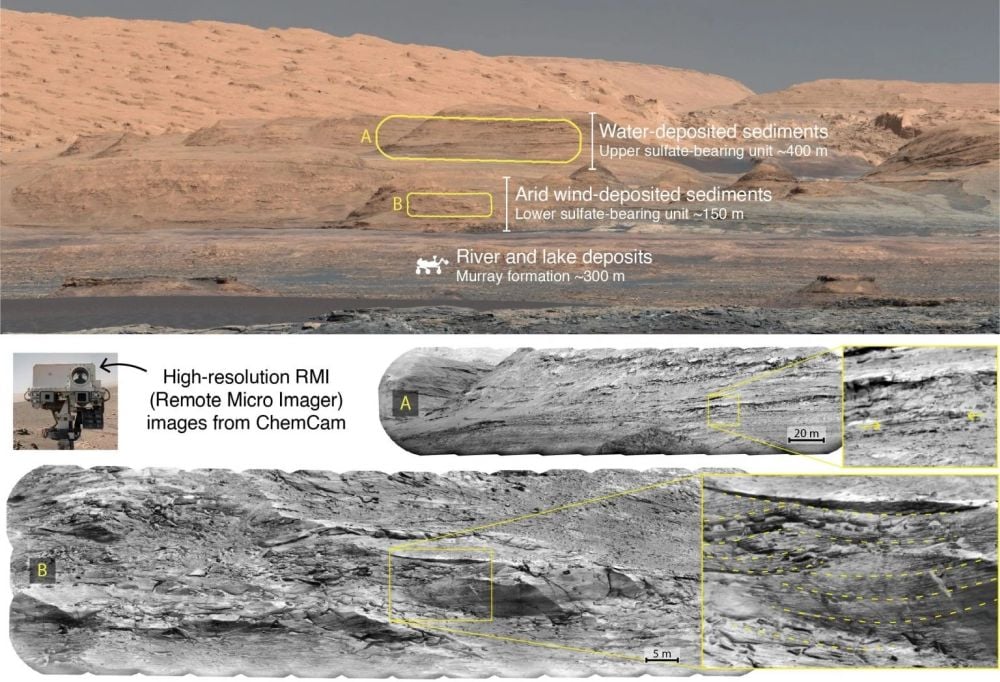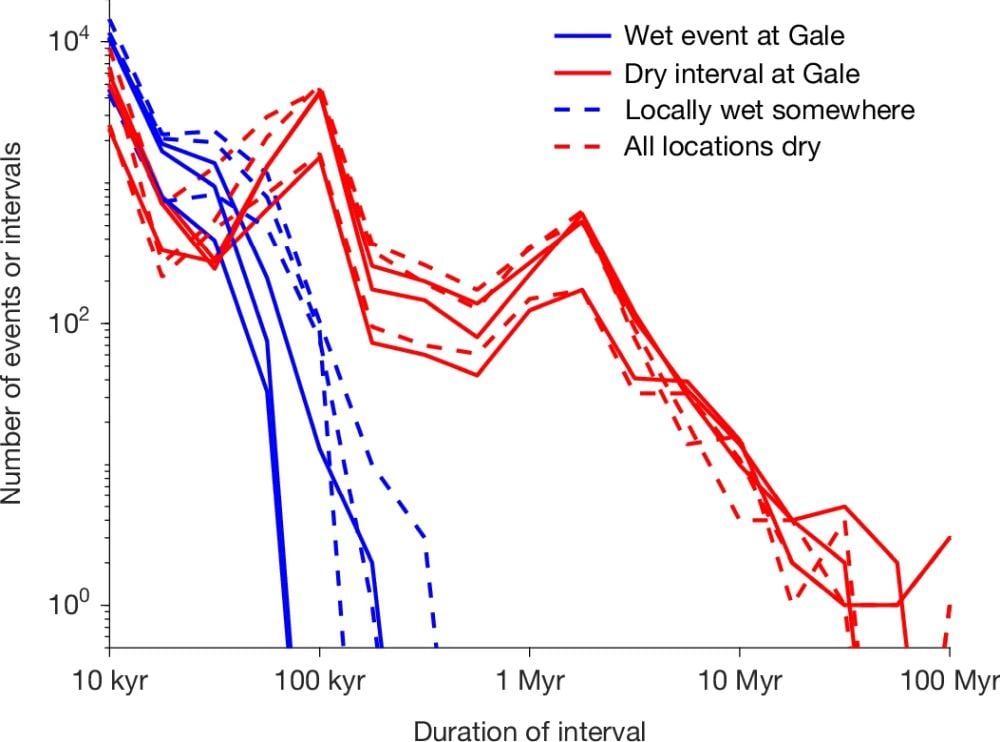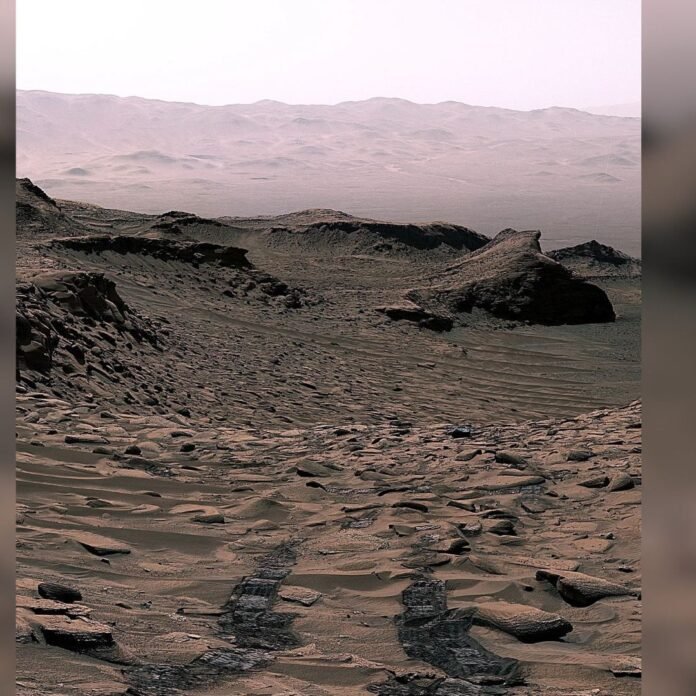Earth is the only habitable world we know of and it remains habitable because of natural cycles that maintain a balanced climate. Earth’s carbon cycle plays a critical role in maintaining its temperate climate, and carbonate rocks are a big part of it. Carbonate rocks like limestone and dolomite are huge carbon sinks, and if their carbon was released into the atmosphere, Earth’s temperature would spike catastrophically, rendering our planet uninhabitable. Conversely, if all of Earth’s carbon were locked away in rock, Earth would likely become glaciated, photosynthesis would cease, and a mass extinction would leave extremophiles as the sole survivors of life’s rich, living heritage.
As long as Earth’s carbon keeps cycling between rock and atmosphere in a reasonable balance, the planet maintains its habitability.
With Earth’s carbon cycle as an example, what can we learn about Mars? There’s rock-solid evidence that Mars had habitable conditions in its past, though those conditions haven’t persisted. The planet was once warm and wet and is now frigid and dry. What part did a carbon cycle play in Mars’s habitability and uninhabitability?
New research in Nature says that Mars went through periods of habitability and uninhabitability due to carbon cycling. It’s titled “Carbonate formation and fluctuating habitability on Mars,” and the lead author is Edwin Kite. Kite is an associate professor of Planetary Science in the Department of Geophysical Sciences at the University of Chicago.
“The cause of Mars’s loss of surface habitability is unclear, with isotopic data suggesting a ‘missing sink’ of carbonate,” the paper states. “Past climates with surface and shallow-subsurface liquid water are recorded by Mars’s sedimentary rocks, including strata in the approximately 4-km-thick record at Gale Crater.” Gale Crater was chosen as MSL Curiosity’s exploration site largely because Mt. Sharp rises more than 5 km and its layered slopes preserve a stratigraphic geological record of Mars’s history. The layers of clays and sulphate-rich deposits show how the planet experienced periods of wetness. The researchers explain that the water was patchy and intermittent, and persisted late into the planet’s history.
 This figure from 2021 research shows some of the detail in Mt. Sharp’s stratigraphic layers. It shows the ancient conditions in which each layer of the mountain formed. Research shows that Mars had alternating periods of wet and dry until it dried out completely about 3 billion years ago. Image Credit: NASA/JPL-Caltech/MSSS/CNES/CNRS/LANL/IRAP/IAS/LPGN
This figure from 2021 research shows some of the detail in Mt. Sharp’s stratigraphic layers. It shows the ancient conditions in which each layer of the mountain formed. Research shows that Mars had alternating periods of wet and dry until it dried out completely about 3 billion years ago. Image Credit: NASA/JPL-Caltech/MSSS/CNES/CNRS/LANL/IRAP/IAS/LPGN
The researchers draw a parallel between Earth’s and Mars’s carbon cycles. They write that Mars’s patchy and intermittent surface water is best explained by a carbon cycle that locks carbon away into sedimentary carbonate rocks. The research is based on NASA’s MSL Curiosity rover and its exploration of Gale Crater. It landed there almost 13 years ago to study the crater’s geology. Among other findings, it measured carbonate materials in the crater and found that they make up 11% of the rocks in the region.
Mars once had a carbon-rich atmosphere, and the authors reference a paper by other researchers showing that stratigraphic layers and carbonate rocks in Gale Crater are clear evidence of that cycle. What drove the cycle?
“Here we show that a negative feedback among solar luminosity, liquid water and carbonate formation can explain the existence of intermittent Martian oases,” Kite and his co-researchers write. They developed a model to illustrate and explain what happened to Mars.
The researchers say that as the Sun has brightened over billions of years, that increasing luminosity supported liquid surface water on Mars. Just like on Earth, available water combined with atmospheric carbon to form weak carbonic acid. That acid created carbonate weathering that acts as a natural thermostat by sequestering carbon into rock.
But things didn’t end there. The atmosphere’s loss of carbon reduced carbon dioxide’s contribution to Mars’s atmospheric pressure. The lower atmospheric pressure allowed water to more easily vaporize away into the atmosphere. The researchers say that Mars underwent cycles of wet periods and dry periods due to chaotic orbital forcing.
 This figure shows histograms of the durations of wet events at Gale and globally in blue. Red shows durations of dry intervals within the time span of wet events. The three different lines of each type correspond to three different random orbital histories. Globally dry periods are sometimes very long and could have driven any surface life to extinction. Image Credit: Kite et al. 2025. Nature.
This figure shows histograms of the durations of wet events at Gale and globally in blue. Red shows durations of dry intervals within the time span of wet events. The three different lines of each type correspond to three different random orbital histories. Globally dry periods are sometimes very long and could have driven any surface life to extinction. Image Credit: Kite et al. 2025. Nature.
Mars suffers from unpredictable and chaotic changes to its axial tilt that affects its climate, and this forcing drives Mars’s carbon cycle and its ancient periods of wet habitability and dry uninhabitability. “The negative feedback restricted liquid water to oases and Mars self-regulated as a desert planet,” the researchers explain. The researchers also explain that Gale Crater’s stratigraphic record “…faithfully records the expected primary episodes of liquid water stability in the surface and near-surface environment.”
During these cycles, the atmosphere eventually thickens and approaches water’s triple point. The triple point is a specific combination of pressure and temperature wherein water can exist in equilibrium in all three phases: vapour, liquid, and solid. Water’s triple point is 0.01 °C (273.16 K) and 611.73 pascals (0.006 atm). The researchers explain that this restricted the sustained stability of liquid water and the planet’s surface habitability.
 This figure from the research illustrates the researchers’ model. a shows the distribution of carbonate detections in sedimentary rocks and soil on Mars, with yellow showing abundant detections, red showing no detections, and brown representing unexplored areas. b shows the fluxes and feedbacks for geologic carbon and climate regulation on Mars and Earth. On Earth, volcanic CO2 output is regulated by rapid carbonate formation. On Mars, solar brightening increased the temperature slowly and is balanced by slow carbonate formation. However, Mars’ chaotic orbital forcing means that water is only available for carbonate formation intermittently during orbital optima, leading to intermittent periods of warmth and surface water. Image Credit: Kite et al. 2025. Nature.
This figure from the research illustrates the researchers’ model. a shows the distribution of carbonate detections in sedimentary rocks and soil on Mars, with yellow showing abundant detections, red showing no detections, and brown representing unexplored areas. b shows the fluxes and feedbacks for geologic carbon and climate regulation on Mars and Earth. On Earth, volcanic CO2 output is regulated by rapid carbonate formation. On Mars, solar brightening increased the temperature slowly and is balanced by slow carbonate formation. However, Mars’ chaotic orbital forcing means that water is only available for carbonate formation intermittently during orbital optima, leading to intermittent periods of warmth and surface water. Image Credit: Kite et al. 2025. Nature.
The researchers’ model has limitations just as all models do. For example, it assumes that the carbonate content at Gale Crater is representative of the whole of Mars. For this reason, they present their research as a testable idea rather than a definitive conclusion.
“Carbonate formation and surface liquid-water availability are linked by a negative feedback that can explain fluctuating habitability on Mars,” the authors write in their conclusion. They write that this cycle can potentially explain the intermittent and patchy nature of oases on Mars, and the sedimentary rocks that entomb those oases. They also say their model can explain how Mars’s surface habitability came to an end, a question that has motivated scientists for a long time, and speaks to our wider questions about life elsewhere in the Universe.


